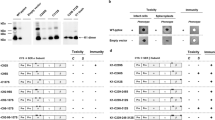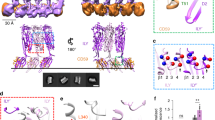Abstract
The toxic action of yeast killer proteins seems to involve selective functional damage to the plasma membrane of the sensitive cell. Physiological effects include leakage of K+ (refs 1, 2), inhibition of active transport of amino acids1,3 and acidification of the cell interior1,4. These effects are strikingly similar to the effects of certain bacterial colicins which have been demonstrated previously to form channels in membranes5. Proposed mechanisms of action have usually postulated a limited permeability change induced by the toxin in the plasma membrane1–4,6,7. We report here that a killer toxin from the yeast Pichia kluyveri forms ion-permeable channels in phospholipid bilayer membranes, and we propose that the in vitro electrophysiological properties of these channels account for the morbid effects observed in intoxicated cells. A preliminary account of this work has appeared elsewhere8.
This is a preview of subscription content, access via your institution
Access options
Subscribe to this journal
Receive 51 print issues and online access
$199.00 per year
only $3.90 per issue
Buy this article
- Purchase on Springer Link
- Instant access to full article PDF
Prices may be subject to local taxes which are calculated during checkout
Similar content being viewed by others
References
Middelbeek, E. J., Stumm, C. & Vogels, G. D. Antonie van Leeuwenhoek 46, 205–220 (1980).
Bussey, H. & Skipper, N. J. Bact. 124, 476–483 (1975).
De la Pena, P., Barros, F., Gascon, S., Ramos, S. & Lazo, P. S. Biochem. biophys. Res. Commun. 96, 544–550 (1980).
De la Pena, P., Barros, F., Gascon, S., Lazo, P. S. & Ramos, S. J. biol. Chem. 256, 10420–10425 (1981).
Schein, S. J., Kagan, B. L. & Finkelstein, A. Nature 276, 159–163 (1978).
Bussey, H. J. gen. Microbiol. 82, 171–179 (1974).
Kotani, H., Shinmyo, A. & Enatsu, T. J. Bact. 129, 640–650 (1977).
Kagan, B. L. & Finkelstein, A. Biophys. J. 37, 208a (1982).
Bussey, H. Adv. microb. Physiol. 22, 93–122 (1981).
Wickner, R. B. Plasmid 2, 303–322 (1979).
Middelbeek, E. J., Crutzen, A. Q. H. & Vogels, G. D. Antimicrob. Ag. Chemother. 18, 519–524 (1980).
Schindler, H. & Rosenbusch, J. P. Proc. natn. Acad. Sci. U.S.A 75, 3751–3755 (1978).
Ehrenstein, G., Lecar, H. & Nossel, R. J. gen. Physiol. 55, 119–133 (1970).
Schein, S. J., Colombini, M. & Finkelstein, A. J. Membrane Biol. 30, 99–120 (1976).
Hille, B. in Handbk of Physiology Vol 1, Pt 1 (eds. Brookhart, J. M. & Mountcastle, V. B.) 99–136 (1977).
Middlebeek, E. J., Hermans, J. M. H. & Stumm, C. Antonie van Leeuwenhoek 45, 437–450 (1979).
Skipper, N. & Bussey, H. J. Bact. 129, 668–677 (1977).
Slayman, C. L. J. gen. Physiol. 49, 93–116 (1965).
Sanders, D. & Slayman, C. L. J. gen. Physiol. 80 (in the press).
Sanders, D., Hanse, U-P., & Slayman, C. L. Proc. natn. Acad. Sci. U.S.A. 78, 5903–5907 (1981).
Seaston, A., Carr, G. & Eddy, A. A. Biochem. J. 154, 669–676 (1976).
Kopecky, A. L., Copeland, C. P. & Lusk, J. E. Proc. natn. Acad. Sci. U.S.A. 72, 4631–4634 (1975).
Konisky, J. in The Bacteria Vol. 6 (eds. Ornston, L. N. & Sokatch, J. R.) 71–136 (Academic, London, 1978).
Jakes, K. S. & Model, P. J. Bact. 138, 770–778 (1979).
Kagan, B. L. thesis, Yeshiva Univ., New York (1982).
Wendt, L. J. Bact. 104, 1236–1241 (1970).
Kagawa, Y. & Racker, E. J. Biol. Chem. 246, 5477–5487 (1971).
Montal, M. Meth. Enzym. 32 b, 545–554 (1974).
Hladky, S. & Haydon, D. A. Biochim. biophys. Acta 274, 294–312 (1972).
Author information
Authors and Affiliations
Rights and permissions
About this article
Cite this article
Kagan, B. Mode of action of yeast killer toxins: channel formation in lipid bilayer membranes. Nature 302, 709–711 (1983). https://doi.org/10.1038/302709a0
Received:
Accepted:
Published:
Issue Date:
DOI: https://doi.org/10.1038/302709a0
This article is cited by
-
Inhibition of Klebsiella pneumoniae carbapenemases by mycocins produced by Wickerhamomyces anomalus
Archives of Microbiology (2022)
-
Amyloidogenic amyloid-β-peptide variants induce microbial agglutination and exert antimicrobial activity
Scientific Reports (2016)
-
Tetrapisispora phaffii killer toxin is a highly specific β-glucanase that disrupts the integrity of the yeast cell wall
Microbial Cell Factories (2009)
-
Technological characteristics of yeast strains and their potential as starter adjuncts in Greek-style black olive fermentation
World Journal of Microbiology and Biotechnology (2006)
-
Amyloid Peptide Channels
Journal of Membrane Biology (2004)
Comments
By submitting a comment you agree to abide by our Terms and Community Guidelines. If you find something abusive or that does not comply with our terms or guidelines please flag it as inappropriate.



